Volume 29, Number 5 September/October 1998
OUR NATURAL RESOURCESOn the Banks of the OhioA trip to one of Illinois' southernmost state parks is a journey to a quieter time If you visit the Cave-In-Rock area of southern Illinois, be prepared to be impressed, both by its beauty and laid-back lifestyles. Visits can even be habit-forming. Just ask Terry and Mary Clark.
In 1985, the Clarks, who were both state employees working in Springfield, found themselves making frequent trips to Cave-In-Rock State Park Lodge to get away from it all.
Terry and Mary aren't the only ones fascinated with the area. It's a place reminiscent of times gone by. There are no neon signs or fast-food chains antagonizing the landscape. The atmosphere is one of "hometown friendly." Mom-and-pop operations are everywhere, including the motel, the tiny gift and dress shops, the quaint antique shop in a converted church and the restaurants, which are filled with the latest news and small town chitchat. The river is king here, dominating most conversations as well as the lives of those who live on its banks.
It was my second visit to the area, only this time the river was up. The high water level created a concern that the Cave-In-Rock Ferry would be forced to shut down and ruined my plans to visit the legendary cave, which was filled with backwater. As the river continued to rise, the days were hazy with only an occasional glimpse of sunshine and sporadic raindrops. I settled in at the Cave-In-Rock Lodge, where I enjoyed the view of the Ohio River September / October 1998 | 43 and the spacious cabin. Accommodations there consist of four duplex cabins, each duplex with its own private bath and balcony offering spectacular a view of the river. Rooms are furnished with two queen-sized beds, lamps, a chair, a television and a dinette set. A small refrigerator and cabinets are available to accommodate snacks and beverages, although cooking is not allowed. Neither are pets.
Rooms are not equipped with telephones, but a public phone is available outside the front door of the restaurant, which also houses the office area. Restaurant hours are 8 a.m. to 7 p.m., with three meals a day and homemade desserts being served. They are delicious and a real favorite among customers. Each year, the restaurant opens for business in mid-March and closes for the winter sometime in November. Cabin rentals, however, are available year-round.
The State Park and Cave
In 1797, when the cave served as a tavern and inn, many an unsuspecting river traveler seeking food, rest and relaxation met instead with an unpleasant demise when robbed and killed in the cave. Numerous exciting and horrifying stories about the 44 | Illinois Parks and Recreation comings and goings at the cave await the ears of curious visitors, and more about its history can be found in the recently updated and released book, The Outlaws of Cave-In-Rock by Otto A. Rothert and Robert Clark, published by Southern Illinois University Press. The cave has attracted Hollywood's attention a time or two. In addition to movies, it has been featured in documentaries.
Although the county is one of the smallest in the state with a population of only 4,300, it is rich in resources and history. Mike Gullett, the site superintendent at the park, was born and raised in the Old Rose Hotel at Elizabethtown. This facility, the oldest public inn in the state dating back to 1812, was established by James McFarland, founder of Elizabethtown. Gullett's great-grandmother, Sarah Rose, operated the hotel from 1884 until her death in 1939. At that time, his grandmother, Charlotte Rose Gullett, became the proprietor of the facility. The hotel and its pavilion, which was erected in 1882 on the edge of the September / October 1998 | 45 bluff in front of the hotel, are landmarks on the Ohio River.
|
46 | Illinois Parks and Recreation
|
OUR NATURAL RESOURCES NEWS BRIEFS
Kepple Named Chairman of Advisory BoardMike Kepple of Dunlap is the new chairman of the Natural Resources Advisory Board.
Kepple is an independent health care consultant and also owns the Peoria Dairy Queen franchise.
"Mike Kepple's knowledge of conservation, love of the outdoors and his willingness to listen to constituents will serve him well as chairman," said DNR director Brent Manning.
Previously vice chair, Kepple has served on
the board since 1993, when he was appointed by Gov. Jim Edgar. He is an avid waterfowl hunter and has represented the board at Mississippi Flyway Council meetings, along with DNR staff.
Kepple will serve a one-year term as chairman. The Natural Resources Advisory Board advises DNR about policies and programs. The board also presides over Department grant hearings. Board members, all of whom are appointed by the governor, serve six-year terms. ž
State Prison Might Boost AquacultureIllinois is poised to become a leader in the aquaculture fish-farming industry with the construction of a fish processing center at the new Pinckneyville state prison. The processing center received $1.25 million in the Illinois state budget approved earlier this summer.
Aquaculture is a fast-growing, multimillion dollar industry that is quickly becoming established nationwide. Several species offish can be farmed in the state, including catfish, trout, striped bass, walleye, perch and tilapia.
Supporters of the program say the development of aquaculture in Illinois will create jobs, have a large economic impact on the state economy, lower fish prices for Illinois customers and strengthen the Illinois agriculture industry.
Because Illinois' current fish-farming industry is small and underdeveloped, the cost of raising fish is so high that private processing centers cannot afford to buy Illinois fish. While farmers in Southern states need to charge only 70 to 75 cents per pound for catfish, Illinois farmers need 80 to 90 cents per pound to make a profit. As a result, Illinois has few fish farmers and no private processing centers to handle farm-raised fish.
The fish processing center in the new state prison will make Illinois fish farmers more competitive because their processing costs will be lower using prison labor to process the fish. Processed fish will be used for both prisoner consumption and sold on the open market.
The processing center will be monitored by the Illinois Department of Public Health. Currently under construction, the Pinckneyville prison is expected to open later this fall. ž September / October 1998 | 47
Beetle Alert in Northeastern IllinoisBy Liz Pensoneau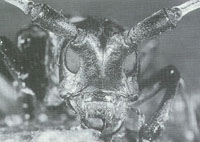 A full-blown, 11x14 colored mug shot of an Asian long-horned beetle is not a pretty sight. Neither is the damage the species has rendered on trees unlucky enough to be in its path. A full-blown, 11x14 colored mug shot of an Asian long-horned beetle is not a pretty sight. Neither is the damage the species has rendered on trees unlucky enough to be in its path.
Last August, residents of Chicago's tree-lined Ravenswood neighborhood discovered their healthy hardwood trees had become the motel for an invasion of the potentially devastating beetle. Federal, state and local officials worked quickly to develop a plan to prevent the beetle from spreading to other areas and to bring about the eradication of the pest. Now, in order for the plan to be successful, public awareness and cooperation are essential.
Since early detection is the key to eradication of this pest, homeowners need to be aware of the following:
• Adult Asian longhorned beetles are large, conspicuous insects with 40 or so white dots marking their shiny, coal-black bodies. Actual size of die beetle's body is 1-1/4 inch, with 2-inch-long antennae. The antennae have alternating black and white bands.
• Adult beetles can live for several weeks, and each female can lay up to 32 eggs. Single eggs are placed into small holes chewed through the bark of a tree.
• Within two weeks, the egg hatches and a tiny larva begins to bore into the inner bark of the tree. As the larva grows to its full length, it tunnels deeper and deeper into the tree, eventually reaching the heartwood. Larval tunnels weaken branches and disrupt the vascular system of infested trees. In late spring, the larva ceases feeding and pupates.
• Two or three weeks later, the pupa transforms into an adult beetle which burrows out of a 3/8 inch diameter exit hole to renew the cycle. The complete cycle usually takes one year, but it can be as long as two years.
• Watch trees for symptoms that include (1) large, circular holes 3/8 to Vi inch in diameter in the trunk or main branches; (2) heavy accumulations of course sawdust in branch crotches or at tree bases; (3) heavy sap flow from holes in bark; and (4) mid-summer leaf yellowing and leaf drop.
• Beetles primarily attack maple trees (Norway, sugar, silver and red), but other hosts can include boxelder, poplar, willow, elm, mulberry, black locust, horsechestnut and plum trees.
The affected area in Chicago has been quarantined to prevent the accidental spread of the beetle. Individuals are prohibited from moving raw wood or insects from within the quarantine zone. Also prohibited is tree-trimming or cutting, since such activities may provoke beetle slights into new uninfested areas.
At this rime, there is no known control of the Asian longhorned beetle, so infested trees will be cut and chipped or burned in the fall to eliminate the larvae. Repeated insecticide treatments have proven to be completely ineffective against larvae deep within the tree.
Scientists believe the beetle arrived in wooden crating material on a ship delivering goods from China. In 1996, it was discovered at two locations in New York, where nearly 2,000 infected trees have been found and removed.
Any sightings of the beetles should be reported immediately to the Illinois Department of Agriculture's hotline at 1.800.641.3934.
Additional information on the Asian longhorned beetle may be obtained by contacting the Department of Natural Resource's Division of Forest Resources, 217.782.2361; the Illinois Natural History Survey, Center for Economic Entomology, 217.333.6656; or James E. Appleby at the University of Illinois Department of Natural Resources and Environmental Sciences, 217.244.3431. ž |
48 | Illinois Parks and Recreation
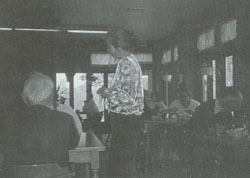 "We fell in love with the area, and Terry often told me he would give anything to look at that scenery every day," Mary said. "Then one day, over a cup of coffee in the Cave-In-Rock Lodge restaurant, I learned some exciting news—news that prompted me to ask Terry if he was really serious about living in Hardin County. He said 'yes,' and the rest is history. Now we're the concessionaires at the lodge and have been for the past eight seasons."
"We fell in love with the area, and Terry often told me he would give anything to look at that scenery every day," Mary said. "Then one day, over a cup of coffee in the Cave-In-Rock Lodge restaurant, I learned some exciting news—news that prompted me to ask Terry if he was really serious about living in Hardin County. He said 'yes,' and the rest is history. Now we're the concessionaires at the lodge and have been for the past eight seasons."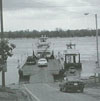 A trip to Cave-In-Rock wouldn't be complete without a ferry ride across the Ohio River to the Kentucky side. Cave-In-Rock residents Lonnie and Shirley Lewis own and operate the ferry, which is subsidized by the states of Kentucky and Illinois. Area residents and tourists alike rely upon its free passage in order to avoid a 35-mile detour to Shawneetown, the site of the nearest bridge.
A trip to Cave-In-Rock wouldn't be complete without a ferry ride across the Ohio River to the Kentucky side. Cave-In-Rock residents Lonnie and Shirley Lewis own and operate the ferry, which is subsidized by the states of Kentucky and Illinois. Area residents and tourists alike rely upon its free passage in order to avoid a 35-mile detour to Shawneetown, the site of the nearest bridge. 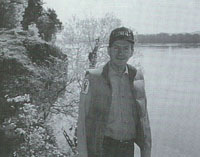 The park's main attraction is its 55-foot-wide cave, which originally gained fame as a headquarters for river pirates who flourished on the Ohio and preyed upon those involved in early travel and commerce between Pittsburgh and the Lower Mississippi. The most feared of these desperados were the Harpe brothers—cutthroat murderers who killed for the thrill of it, torturing their victims and terrorizing all who came in contact with them. Dread of these outlaws, reports say, "brought peaceful settlers together in communities and helped to hasten the establishment of law and order."
The park's main attraction is its 55-foot-wide cave, which originally gained fame as a headquarters for river pirates who flourished on the Ohio and preyed upon those involved in early travel and commerce between Pittsburgh and the Lower Mississippi. The most feared of these desperados were the Harpe brothers—cutthroat murderers who killed for the thrill of it, torturing their victims and terrorizing all who came in contact with them. Dread of these outlaws, reports say, "brought peaceful settlers together in communities and helped to hasten the establishment of law and order."
 Visitors to the Hardin County area will also be pleased to discover Cave-In-Rock State Park's campground facilities, offering 34 Class B sites with electrical hookups. There are 25 Class C sites for tent campers. Water is available, there is a sanitary dumping station, and a shower facility is in the planning stages.
Visitors to the Hardin County area will also be pleased to discover Cave-In-Rock State Park's campground facilities, offering 34 Class B sites with electrical hookups. There are 25 Class C sites for tent campers. Water is available, there is a sanitary dumping station, and a shower facility is in the planning stages.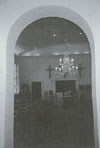 Elizabethtown
Elizabethtown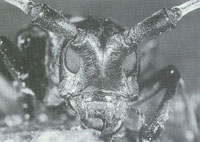 A couple of blocks north at the town's main intersection, the Town and Country restaurant is filled with good eats at reasonable prices. Here, a most impressive collection of Coca-Cola memorabilia awaits visitors. Another favorite eating spot famous for its fish is the E'Town River Restaurant, a floating eatery. Other historic gems about town include the courthouse and the First Baptist Church, which is the oldest Baptist church in Illinois with continuous service. Its ministry dates back to 1806.
A couple of blocks north at the town's main intersection, the Town and Country restaurant is filled with good eats at reasonable prices. Here, a most impressive collection of Coca-Cola memorabilia awaits visitors. Another favorite eating spot famous for its fish is the E'Town River Restaurant, a floating eatery. Other historic gems about town include the courthouse and the First Baptist Church, which is the oldest Baptist church in Illinois with continuous service. Its ministry dates back to 1806.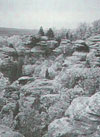 Other Area Attractions
Other Area Attractions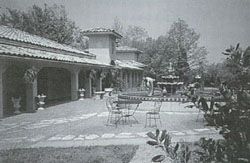 • San Damiano, a retreat center and shrine located northeast of Golconda, is a wonderful getaway destination. Its 200 acres on the bluffs overlooking the Ohio River are surrounded by miles and miles of the Shawnee National Forest. San Damiano has 26 air-conditioned cottages, a visitor and conference center, a weekend restaurant. Civil War cemetery, hiking trails, a wildlife refuge, chapel, shrine and prayer garden, and meditation area. It also offers fishing in the Ohio River. Operated as a not-for-profit facility by the Catholic Shrine Pilgrimage, it is open to people of all faiths. For additional information, call 618.285.3507 between 8 a.m. and 5 p.m.
• San Damiano, a retreat center and shrine located northeast of Golconda, is a wonderful getaway destination. Its 200 acres on the bluffs overlooking the Ohio River are surrounded by miles and miles of the Shawnee National Forest. San Damiano has 26 air-conditioned cottages, a visitor and conference center, a weekend restaurant. Civil War cemetery, hiking trails, a wildlife refuge, chapel, shrine and prayer garden, and meditation area. It also offers fishing in the Ohio River. Operated as a not-for-profit facility by the Catholic Shrine Pilgrimage, it is open to people of all faiths. For additional information, call 618.285.3507 between 8 a.m. and 5 p.m.